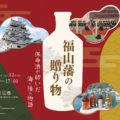KANSAI GEOGRAPHICAL INDICATION
関西の地理的表示
The following is a part of 48 Japanese GI products that are protected in the EU.(as of September 2020).
日本の GI 産品のうち、EU 内で保護される日本の GI48 品をご紹介します。(2020年9月現在 )
TOKUSAN MATSUSAKA USHI
特産松阪牛 
TOKUSAN MATSUSAKA USHI refers only to carefully selected Hyogo Prefecture-born Japanese black-haired virgin female cattle with an age not exceeding12 months. They are then reared in the area of Matsusaka City and other designated municipalities in Mie Prefecture for more than 900 days. Its meat has a finely marbled appearance, a sweet elegant fragrance, and a soft melting texture. Analysis of the fat content confirmed that the proportion of components with a low melting temperature is significantly higher in this breed than that of other Japanese black cattle species, which is the reason for the mellow, melting texture of Tokusan Matsusaka Ushi.

特産松阪牛は、兵庫県で生まれた12ヶ月齢までの黒毛和種の未経産雌牛を厳選し、三重県内の松阪市ほか指定された市町村の区域内に導入し、その生産地のみで900日以上肥育し、かつ、その生産地で肥育を終える肉用牛です。その肉質は、キメ細かなサシと甘く上品な香り、そして柔らかく脂がとろけるような舌触りが特徴です。脂肪成分を分析すると、同じ30ケ月齢の黒毛和種と比較して脂肪が溶け出す温度が低く、柔らかく脂がとろけるような舌触りを裏付けています。
OMI USHI
近江牛
-scaled-e1608614506860.jpg)
Full of oleic acid, an unsaturated fatty acid with a low melting point, this excellent, fatty beef practically melts in your mouth. One of the oldest brands of beef in the country, produced for almost 400 years, Omi Ushi (Omi Beef) has long since been considered one of the three principal varieties of beef due to its contribution to the beef-eating culture of Japan and thanks to its fattening techniques. During the Edo period, when eating beef was prohibited by law, the Hikone Domain in the Kansai region was the only area in the country given special permission to cultivate beef on account of its contributions to the Shogunate. Using the plentiful waters of Lake Biwa for rice cultivation, the area developed special techniques for fattening cattle with rice straw. Since the Taisho period, when beef fattening was encouraged by the government, the producer established the Omi Beef Association, a Wagyu beef promotional organization devoted to raising beef for consumption, and have worked hard ever since to help promote cattle farming.
融点が低い不飽和脂肪酸であるオレイン酸を多く含んでおり、脂質の口溶けの良い牛肉です。約400年前から生産が続く最も古い銘柄牛のひとつであり、日本の牛肉食文化への貢献や肥育技術の高さから日本三大和牛とも称されます。牛肉食が禁止されていた江戸時代、彦根藩は将軍家への献上のため、唯一、牛肉の生産が許されていました。琵琶湖の豊かな水に恵まれ稲作が盛んであったことから、稲わらを中心に給餌する肥育技術が発達。大正時代から肥育振興策が行われ、1951年には、日本初のブランド牛肉振興団体「近江肉牛協会」を設立するなど、わが国で最も古くから和牛生産に取り組んでいます。
MANGANJI AMATOU
万願寺甘とう
MANGANJI AMATOU is a green pepper which is cultivated in AyabeCity, Maizuru City, and Fukuchiyama City, Kyoto-fu. It is not spicy and is exclusively used for its edible flesh. It is bigger than varieties such as Fushimi red pepper grown in Kyoto-fu, with a length from 10 to 23 cm, and its skin is thick like that of a green pepper. The taste has a distinctive flavour and sweetness with a rustic accent, and although it is a large pepper, the fruits are soft with few seeds, and easy to eat. Compared to other large chilli peppers, there is a clear difference in appearance in its pinched neck and slightly curved shape.
辛みがなく、もっぱら果肉自体を食用とするとうがらしで、夏季に出荷のピークを迎えます。京都府内で作られている「伏見とうがらし」などの品種と比べて大型で、長さは10cmから23cmもあり、果皮はピーマンのように肉厚です。食味は、野趣あふれる独特の風味と甘味を備えており、大型果なのに果実が柔らかく、タネが少ないため食べやすいのが特徴です。また、他の大型とうがらしと比べて、外観における肩部のくびれとやや湾曲した果形において明確な違いがあります。
TAJIMA GYU
但馬牛

TAJIMA GYU (TAJIMA BEEF) is produced from high grade Tajima cattle over the age of at least 28 months, with an average age of about 32 months, reared in Hyogo Prefecture. Tajima cattle have been raised as livestock for about 1,200 years in the mountains of the Tajima region in the northern part of Hyogo Prefecture, an ideal natural environment where there is clear air, pure streams and abundant mountain grass. In the Meiji era (1868-1912), its gene became recognized for high-quality pedigree cattle.As a meat, Tajima beef began to be eaten when the port of Kobe opened in 1886. It is said that foreigners who came to Japan at that time ate Tajima Beef and were captivated by its taste.
兵庫県で生産される優れた但馬牛(タジマウシ)を素牛として、最低月齢28カ月以上、平均32カ月程度かけて仕上げていく牛肉です。約1200年も昔から兵庫県北部の但馬地方の山あいで、農耕用の役牛として、澄みきった空気、清らかな渓流、豊富な山野草など恵まれた自然環境に育まれてきましたが、明治期においてその遺伝子が肉牛としての良質な血統であることが認識されるようになりました。食肉として但馬牛(タジマウシ)が食べられるようになったのは、1886年の神戸港の開港時。日本へ来た外国人が口にし、その美味しさのとりこになったと伝えられています。
KOBE BEEF
神戸ビーフ

KOBE BEEF is the beef produced from high grade Tajima cattle raised in Hyogo Prefecture, over the age of at least 28 months. It takes an average of about 32 months to create the ideal meat quality.The meat is fine and soft with fat finely ingrained in the muscle, and has the finest quality of “marbled meat” with the fresh red colour of the muscle and white colour of the fat criss-crossing each other. When eaten it feels soft and pleasant on the tongue, and it melts in the mouth with a mellowness and unique flavour.

兵庫県で生産される優れた但馬牛(タジマウシ)を素牛として、最低月齢28カ月以上、平均32カ月程度かけて理想の肉質に近づけていく最高牛肉です。肉質は、キメが細くて柔らかく、脂肪が筋肉に細かく入り込み、筋肉の鮮紅色と脂肪の白色が鮮やかに交雑する最高級の「霜ふり肉」です。他の産地の一般的な牛肉と比べて、脂肪の中におけるモノ不飽和脂肪酸の割合が高いことに由来すると考えられています。賞味すれば、舌ざわりが良く、とろけるようなまろやかさが口一杯に広がり、特有の風味を醸し出します。
MIWA SOMEN
三輪素麺

MIWA SOMEN is produced in Miwa, the birthplace of hand-rolled somen, and is a traditional noodle dating back to the Nara period. They have good elasticity, excellent stretchability, and are very thin. Their texture is highly appreciated, and they are presented to the Imperial Household Agency every year.The production of somen in Miwa reputedly started about 1300 years ago for the relief of people suffering from famine and the plague at Omiwa Shrine, the oldest shrine in Japan. The method of making Miwa Somen is a traditional one which prepares very thin noodles with high elasticity. The delicacy of the noodles is of the highest grade and contains more than 95 strands per 10g.

手延べ素麺発祥の地の三輪で生産され、その起源は奈良時代まで遡る伝統ある素麺です。伸縮性に優れており、非常に細い製麺が可能であり、また茹で上げ後の茹で伸びが抑制できます。その食感は高く評価され、毎年、宮内庁に献上しています。三輪における素麺作りは、約1300年前、日本最古の神社である大神神社(おおみわじんじゃ)で飢饉と疫病に苦しむ民の救済のために始まりました。その製法は、強いコシを持たせ、非常に細く製麺する伝統的なもので、麺の細さは、最上級品で10g当たり95本以上と規定されています。
KISHU KINZANJI MISO
紀州金山寺味噌

Unlike rice and wheat-based miso pastes, Kishu Kinzanji Miso is not used for seasoning but rather is eaten as it is. It is said that the method of production of this miso was brought back from the Song Dynasty in China during the Kamakura period to the area now known as Wakayama Prefecture. Kishu Kinzanji Miso is made from Koji, which is made of soy, stripped barley and rice, as well as melon, eggplant, ginger, and shiso, a method not found in other kinds of Kinzanji Miso pastes from other parts of the country, giving it a distinctive texture and mellow flavour depending on the particular combination of ingredients.
米味噌や麦味噌等のように調味に使用するものではなく、そのまま食べる味噌で、その製法は、鎌倉時代に宋から和歌山に持ち帰られたものが起源であるという説が有力です。なかでも紀州金山寺味噌は、麹の原料として、大豆、裸麦(大麦)、米の3種類の全てを使用し、具材として瓜、茄子、生姜、紫蘇の全てを用いるという他の地域の金山寺味噌にはない製法を有しており、具材の混ざり具合に応じて様々な食感や食味、まろやかな味が得られるのが特徴です。







